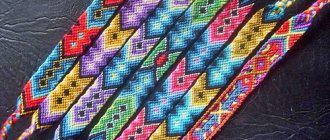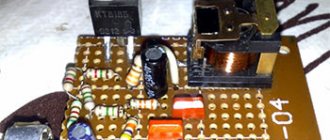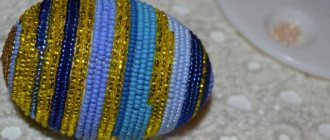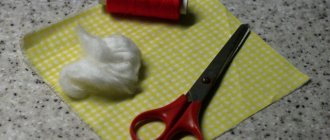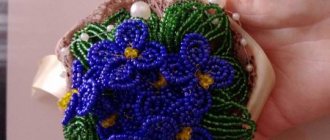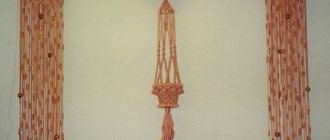A paracord clothing or weapon belt is an indispensable attribute of a real man. He will come to the rescue in a situation that requires an urgent solution - hiking, hunting, construction work, towing a car, applying a splint to a fracture, and even stitching up wounds. Paracord products are distinguished by their durability, water-repellent and fire-resistant properties, as well as ease of manufacture. A flexible and comfortable belt made of paracord cord can be woven quite easily if you follow the instructions. We will tell you how to choose the right material, calculate the length of the product and what techniques are best for making a belt.
To make a high-quality paracord belt with your own hands, you should strictly follow the instructions at all stages and take into account all the nuances. For example, the initial length of the lace must be clearly calculated according to a certain formula and in no case “by eye”, and the diameter of the paracord cord will affect the possibilities of further use. If you take into account all the nuances, you will end up with a product that will surpass the quality of store-bought analogues. If desired, the belt can be supplemented with inserts - a knife buckle, a compass, a watch, a flint or an amulet, for example, Thor's hammer.
Important Details
When planning the process of making a homemade belt and thinking about how to make a belt with your own hands, you need to understand in what situations it is needed.
Many people want to wear the same accessory with both trousers and jeans. But the former have narrower belt loops, while the jeans have wider belt loops. However, trousers are different from trousers. Therefore, you should measure using an old belt of the same width and draw conclusions based on the results of the measurements.
If the buckle has only one section, you will need an additional belt loop on your trousers or jeans (their width should not be more than one and a half centimeters). When there are more sections, belt loops are not needed.
For sewing a belt, it is better to choose a strong, thick thread. It would be good if it contained a weave of several thin threads.
When making fastening, and at the same time decor, with thread, they try to choose a wider “pitch” of stitches. It's not obligatory. Frequent stitches also look good.
How to knit grosgrain knots for a macrame belt
In order to weave the belt described here, you need to learn how to knit several types of knots. Beginning craftswomen first need to practice on a small piece of thread, otherwise it can take a long time to create an accurate belt.
Learning to knit knots using the macrame technique:
- Rep knots can be vertical or horizontal. They are used in almost all macrame products. In order to tie a series of horizontal rep knots, you need to tie knots on the working thread with the elements included in the brid as follows: the auxiliary cord makes two turns from bottom to top around the worker, and then the auxiliary cord is passed into the loop formed between these turns and the entire structure is tightened. Thus, we knit knots with all the threads that make up the brid. If you weave an element from left to right, then such knots are performed with the left hand, if vice versa, then with the right.
- Brida is a collection of rep nodes. To weave this belt you will need the skill of weaving horizontal and diagonal bridles. To place the bridka horizontally, you need to tie knots on the working thread parallel to the buckle. To place a row of knots diagonally, the working thread must run diagonally.
Rep knots are one of the most ancient elements in macrame; they are used in almost all products made using this technique. Before you start, practice weaving horizontal and diagonal bridles.
Do I need to glue the fold of the belt around the buckle?
When making a leather belt with your own hands, you should pay attention to this issue. Gluing will visually improve the design.
If you leave everything as is, securing this place only with rivets, the edge will look unattractively sticking out, more like a sandwich panel.
By the way, the decision about gluing should be made before the rivets are placed, since the first step in this process will be to tighten the sides with glue, and then apply screws (rivets) near the buckle, thereby fixing it.
- Do-it-yourself kokoshnik: 80 photos of making and recommendations on how to make a beautiful headdress
- DIY bows - the best ideas and a master class on how to make a beautiful bow quickly and easily (100 photos)
- What are paintings by numbers?
Macrame belt pattern
A woven belt will make your look more modern and unusual. It will take a little time to make it (from 2 days to a week). When making belts, the threads need to be tightened sufficiently tightly, this way you will be able to increase the strength and service life of the product.
Master class on making a belt using the macrame technique:
- Make 7 pieces of thread 4 meters long. Hang the remaining 6 pieces onto one of the threads, folding each in half and passing the ends into the resulting loop.
- Count 7 threads to the left and 7 threads to the right, and attach the middle of the structure with a pin to a horizontal or vertical surface.
- We count the 8th thread from the left and weave a diagonal bridle on it with rep knots using all the free threads to the left of it.
- We count the 7th thread from the right and weave a diagonal bridle on it with rep knots using all the free threads to the right of it.
- We make one more such row on the left and right sides. You should end up with a kind of Christmas tree consisting of 3 rows.
- We take the 4 threads in and tie them into a square knot.
- Divide the 4 threads coming out of the square knot in half (you should end up with 2 threads on the left and 2 on the right). We take the 2 left threads and add 2 more adjacent threads to them, tie them into a square knot.
- We perform the same operation with the right threads.
- To weave the third row of square knots, you need to take one thread to the sides, located on the edge of the right and left sides. Using the next 12 strands, weave a row of 3 square knots.
- In the next row, pull out 3 outer threads on the left and right sides. From the remaining threads, weave a horizontal structure consisting of 2 square knots.
- Now take 5 threads from each side and weave one square knot from the remaining 4 threads in the center.
- On the first thread on the left side, weave a briddle of 6 rep knots to the right side.
- Now weave the same bridle on the right side, but it should consist of 7 rep knots.
- Make another row of left and right brids.
- Take the 4 central threads and make a column of 2 square knots from them. You should have 5 free threads left on the left and right sides.
- Take the left free threads and tie 4 rep knots to the left on the thread closest to the center. You should end up with a horizontal bridge.
- Now do the same on the right side.
- Take the thread on the far right and tie a briddle of 4 rep knots on it to the left side, close to the previous row.
- Take the thread on the far left and tie 4 rep knots on them to the left.
- The next row should start from the 5th thread on the right edge and knit knots on it to the right side at some distance from the previous row.
- Tie the brid on the left side in exactly the same way.
- The next left and right row are knitted in the same way, but right next to the previous row.
- Now tie the left and right brids a short distance from the previous row.
- Then make one more left and right row next to the previous one.
- Count the 7th thread on the left side and tie a bridle of 6 rep knots on it to the left.
- In the same way, tie the bridle on the right side.
- Make another row of brids on each side.
- Repeat the above steps, starting from step 6, until the belt reaches the desired length.
The end of the belt should be equal to the width of the buckle. When the work is finished, the remaining threads need to be set on fire with a soldering iron or lighter and the buckle must be attached. You can buy a belt holder, or you can make it yourself by weaving it with square knots.
LiveInternetLiveInternet
—Categories
- PAPER MAKING (536)
- =iris-folding,quilling,pergamano= (34)
- =from paper= (148)
- =cardboard= (116)
- = kirigami, vytynanki, origami = (44)
- =papier-mâché= (66)
- =scrapbooking= (47)
- =gift packaging= (112)
- EMBROIDERY (596)
- = beads, pearls = (33)
- = longstitch,bargello= (31)
- =blackwork= (40)
- =isothread= (14)
- =cross+Bulgarian= (290)
- =ribbons= (25)
- =hemming, seams, stitches= (27)
- =on checked fabric+sashiko= (18)
- =plastic canvas= (31)
- =different techniques= (93)
- =rococo= (10)
- WARDROBE (132)
- =accessories= (78)
- =clothes and shoes= (57)
- COUNTRY LIFE (1181)
- =vases and flower beds= (100)
- =country tricks= (134)
- =ornamental plants and flowers= (141)
- =for a do-it-yourself dacha= (161)
- =house, yard and everything around= (140)
- =protection and treatment of plants= (47)
- =indoor flowers= (45)
- =beautiful cottage= (139)
- =landscape design= (122)
- =garden= (114)
- =fruit trees and shrubs= (57)
- =garden sculpture and decorations= (229)
- DECOR (268)
- =decorating items= (126)
- =imitation= (102)
- =techniques= (56)
- HOUSEHOLD CASES (358)
- =interior= (194)
- =space organization= (65)
- =good to know= (105)
- CHILDREN (90)
- =games and activities for children= (23)
- =miscellaneous= (29)
- =educational= (39)
- FOR THE SOUL AND MIND (2347)
- =architecture= (56)
- =ah, this woman from the portrait. = (73)
- = library, audio books, performances, cinema = (261)
- =eternal= (71)
- =virtual travel= (71)
- =arts and crafts= (163)
- =painting= (396)
- =my beast= (63)
- =interesting= (88)
- =medical stories= (1)
- =music= (49)
- =still lifes- (8)
- =unknown= (8)
- =prose= (50)
- =psychology, philosophy of life= (72)
- =sculpture= (17)
- =classic poems= (205)
- =poems2= (353)
- =poems3= (149)
- =poems= (350)
- =fate= (28)
- =English lessons= (29)
- =photo= (84)
- =phrases, humor= (77)
- =temples= (100)
- =flowers in poetry and painting= (22)
- =jewelry, costume jewelry= (22)
- HISTORY (168)
- =archaeology= (7)
- =Great Patriotic War= (35)
- =cities and villages= (38)
- =foreigners in Russia= (19)
- =history of things= (25)
- =history of Russia= (13)
- =society,politics= (33)
- PICTURES, STENCIL (211)
- =animals and birds= (40)
- =people, fairies, elves= (30)
- =New Year's= (14)
- = ornament, corners, vignettes + ethnic = (48)
- =miscellaneous k= (60)
- =plants, flowers= (25)
- COMPUTER (251)
- animation, postcards (49)
- programs, links, help (111)
- textbook LIRU (75)
- photoshop (20)
- BEAUTY AND HEALTH (500)
- =homemade cosmetics and perfumes= (156)
- =diseases= (26)
- =sets of exercises= (57)
- =medicinal plants= (47)
- =non-traditional treatment methods= (17)
- = vegetable oils / treatment, cosmetology / = (20)
- =health recipes= (112)
- =weight loss= (39)
- =hair care= (29)
- =care for face, hands, body= (36)
- =emergency= (7)
- CULINARY RECIPES (2852)
- =alcoholic drinks= (38)
- = pancakes, pancakes, pancakes = (86)
- =savory baked goods= (108)
- =sweet pastries= (117)
- =country kitchen= (99)
- =desserts, homemade sweets, candies= (246)
- =dietary,lenten,vegetarian= (212)
- =magazines= (101)
- =preparations - not only for the winter= (249)
- =snacks= (195)
- = homemade sausage, rolls, lard = (71)
- =creams, mastic, glaze= (40)
- =cereals, vegetables, mushrooms= (289)
- =bow= (1)
- =I love pasta= (33)
- =microwave= (33)
- =multi-cooker= (18)
- =meat= (69)
- =drinks= (55)
- =national dishes= (71)
- = dumplings, manti, dumplings, dumplings, dumplings = (81)
- =cookies, gingerbread = (122)
- =receiving guests= (23)
- =bird= (165)
- =miscellaneous= (35)
- =recipes for thrifty housewife= (8)
- =fish, seafood= (148)
- =salads= (151)
- =beets= (50)
- =sauces, dressings, gravies= (74)
- =offal= (37)
- =soups= (104)
- =tagine= (7)
- = cottage cheese, milk, cheese, eggs = (109)
- =dough/recipes+beautiful cutting/= (62)
- =cakes, pastries, cupcakes= (131)
- =pumpkin= (113)
- =decoration of all dishes= (82)
- =bread, cakes= (80)
- =electric dryer= (37)
- MOLDING (192)
- =polymer clay, plastic= (113)
- =salt dough= (44)
- =cold porcelain= (45)
- MINIATURE (146)
- =houses and interior= (92)
- =inedible edibles= (25)
- =shoes, bags, accessories= (24)
- =clothes, hats= (6)
- WEAVING (343)
- =from magazines= (110)
- =wire+beads= (126)
- =from twigs, daylilies= (11)
- = from cords, ribbons, fabric, rope = (58)
- =macrame= (33)
- =miscellaneous= (8)
- HOLIDAY (812)
- =September 1= (3)
- =February 14= (72)
- =February 23= (6)
- =March 8= (7)
- =angels= (33)
- =wreaths= (42)
- =gift ideas= (82)
- =New Year's 2014= (240)
- =New Year's 2015= (69)
- =New Year's 2016,17,18,19= (105)
- =Easter= (172)
- =holiday decor= (24)
- PAINTING (200)
- =stained glass painting= (36)
- =dying, fabric painting= (18)
- =dot painting= (67)
- =drawing lessons= (83)
- HANDMADE (2651)
- =butterflies= (75)
- =panel= (44)
- bottles, jars, vases (252)
- video master classes (56)
- knitting (66)
- gypsum, cement, foam (83)
- decoupage (187)
- wooden crafts (38)
- stones, pebbles and shells (92)
- books and magazines /crafts/ (47)
- leather, leatherette (96)
- dolls and toys (231)
- materials and tools for creativity (100)
- furniture/do-it-yourself/restoration/ (114)
- mosaic (81)
- soap stories (114)
- threads, rope, twine (93)
- necessary from unnecessary (187)
- plastic. bottles, caps, bags, disposable tableware (83)
- candy gifts (119)
- natural material, cereals, pasta (84)
- button (66)
- needlewoman's workplace (24)
- various handicrafts (110)
- crafts (8)
- lamps (42)
- candles and candlesticks (59)
- CDs, jars, labels (19)
- textiles (120)
- topiary, trees (68)
- felt, felting, burlap (83)
- foil (8)
- epoxy resin (17)
- JEWELRY (330)
- =ABC= (10)
- =bracelets= (67)
- =brooches= (37)
- =beads, necklaces, necklaces= (73)
- =for hair= (18)
- = pendants, earrings, rings = (22)
- =soutache= (13)
- =other jewelry= (103)
- FLOWERS (511)
- =from paper= (105)
- =leather, fur= (27)
- = from ribbons, braid = (75)
- = made of fabric, felt = (87)
- =we mold from everything= (29)
- =miscellaneous= (89)
- =floristry= (101)
- =foamiran= (12)
- SEWING (943)
- =ABC of sewing= (62)
- =applique= (31)
- =for home= (69)
- =leather and fur= (21)
- =patchwork, quilt= (287)
- = alterations, repairs = (68)
- =various pillows= (200)
- =you can’t throw away old jeans!= (51)
- =sewing= (139)
- =curtains= (37)
- =we sew for children= (47)
Macrame belt for beginners: weaving square knots
The square knot has an openwork weave. It consists of a left-sided and right-sided flat node. It is performed as follows: take 4 threads (the 1st and 4th will be working, and the 2nd and 3rd will be the main ones), pass the 1st thread under the two main ones, then take the 4th thread and placing it under Place the 1st one on top of the 2nd and 3rd, and thread its free end into the bend of 1 thread.
Columns can be made from such knots, and if the first square knot starts from a left-sided element, then the next one should also start from a left-sided one.
Before you move on to making a belt, you should pay special attention to the technique of weaving diagonal and horizontal bridles, and also try to knit a chain of square knots. The master class of this belt is selected in such a way that even a beginner can handle weaving all its elements.
Myths about paracord
Survival in extreme conditions is always difficult for a person. It is difficult to live even for a couple of days without the usual benefits of civilization and the most necessary items. But there are people who like to consciously test themselves for strength, strengthening their character and fortitude.
First of all, physical endurance, unpretentiousness, ingenuity help them survive, and only then - improvised means. Paracord, used to equip parachutes, became precisely such a means.
The first to figure out how to use it were American paratroopers. It was they who came up with the idea to weave stylish, functional jewelry from durable rope.
The idea of making paracord bracelets belongs to American paratroopers.
The main feature of the accessory is that it is easy to tie and even easier to unravel if necessary. Soon, wearing such bracelets became completely justified.
Weaving such survival bracelets does not require special knowledge and skills. This useful decoration is easy to make yourself, with just a little practice. It can save lives in an unforeseen situation, and this does not necessarily mean survival in the forest. The bracelet will come in handy both when hiking, fishing, hunting, and in everyday life.
Have you ever made paracord bracelets? For what purpose? Share your experience in the comments.
What is paracord and its scope of application
Previously, such a cord was used only by American paratroopers to survive in difficult conditions. It could be used to splint a fracture, stop bleeding, sew up a wound, make a trap for hunting small animals, or use it as fishing line.
From the cord obtained from an unbraided bracelet, you can make a tourniquet
Paracord was indispensable as a safety rope when climbing rocks; it could be used to install a tent awning or secure a sail to a raft. A little later, the unique material became available to civilians.
Wherever this strong, durable rope was not used. Housewives dried laundry on it, and tourists used it to strengthen tents and hang hammocks. Paracord was used to secure the cargo being transported to vehicles, and with its help, rescuers helped drowning people get to shore.
On extreme hikes you can’t do without a strong rope. It is much more convenient not to drag a bulky skein with you, but to weave a bracelet from it. Every experienced survivalist will appreciate such a useful accessory.
A paracord bracelet is not only a stylish accessory, but also an indispensable assistant in an emergency.
Composition of paracord
A strong cable consists of an inner core and an outer braid. Inside there are several thin and very durable laces, each of which is woven from 3-4 even thinner ones.
The outer part of the paracord is woven from a large number of very thin nylon threads and is a solid, tube-shaped fabric. The main load always falls on the braid, because even if the core is pulled out, the hollow rope can support the weight of two people.
Inside the cord there are several dense threads, on top of which a thin colored braid is applied. The load capacity largely depends on the thickness of the rope, the number of internal laces and the material from which they are made. So, if a skein of paracord weighs on average 100 g, then it can withstand a load of more than 260 kg.
Additional functionality of a paracord bracelet
As mentioned above, special additional accessories turn paracord bracelets into multifunctional jewelry. Inside, when weaving, various things necessary for the hike are placed. Both simple plastic carbines and flint and piercing and cutting objects can be used as a fastener.
Military tactical bracelets can often contain up to 10 different attachments.
Among them are:
- wrench;
- screwdriver;
- compass;
- can-opener;
- whistle;
- multitool;
- watch;
- thermometer.
Inside the bracelet there may be additional elements for survival in the wild.
In extreme conditions, it is important that the bracelet quickly unravels. When weaving correctly, only 10 seconds are enough to completely unwind the cord.
If you want to combine practicality in use with beauty and style, then you can use decorative elements in the form of a skull, anchor, or hammer as a clasp.
Colors and decor
If the bracelet is used only as a beautiful accessory, then it can be woven from 4-5 ropes of different colors. It will no longer be possible to unravel it, and the length of the laces will be short. A functional survival bracelet is woven from one, maximum two cables.
Everyone chooses color combinations to their own taste, but the most popular are blue-white or red-green contrasting shades. These bracelets look very beautiful and can be easily unwoven if necessary.
The most popular two-color bracelet options
Young people prefer complex weaving with decorative elements and bright colors. Making such a bracelet yourself is not at all easy; you need certain skills and experience. It’s easier to buy ready-made jewelry in a store, since the choice of such accessories is quite wide.
Technology of weaving Russian belts
(developed by M.A. Boyko, teacher at children's art school, Moscow)
Belts were made, as a rule, from multi-colored woolen threads, sometimes with the addition of linen (less often, silk). Their patterns were very diverse - from simple longitudinal or transverse stripes to beveled geometric motifs, made using the bran method (on boards). Folk belts were made long, their ends were decorated with lush tassels, and trimmed with beads, bugles, and cannon balls.
The colors for the belt were mostly chosen to be bright and contrasting, but folk craftswomen knew how to avoid excessive variegation - all multi-color schemes were subordinated to one leading color: red, orange-yellow or another.
An elegant colorful belt served as an addition to the folk costume, both women's and men's. Belts were made in different ways.
Belts
Tools you will need for the job
In addition to the paracord itself and the weaving pattern, you need to stock up on sharp scissors, matches or a lighter for burning the ends of the rope, a carabiner, an anchor or a fastex fastener.
Tools and materials needed for knitting an accessory
You will also need tweezers or a special needle for leather cords. It is a metal knitting needle with a sharp tip, and instead of the usual eye of a needle, there is a groove with a thread on it.
The end of the paracord needs to be slightly melted and inserted into the thread, and when it cools, it will be tightly fixed inside. After finishing the work, the needle can be easily removed without damaging the product.
Typically, bracelets are woven by hand, without the use of various devices. However, advanced craftsmen have come up with a special weaving machine that makes the work much easier.
Machine for weaving paracord bracelets
Find out the price on AliExpress
You can buy it at any craft store or make it yourself. The paracord is tightly attached to the loom, and the built-in ruler allows you to weave a product of the required size without additional measurements.


